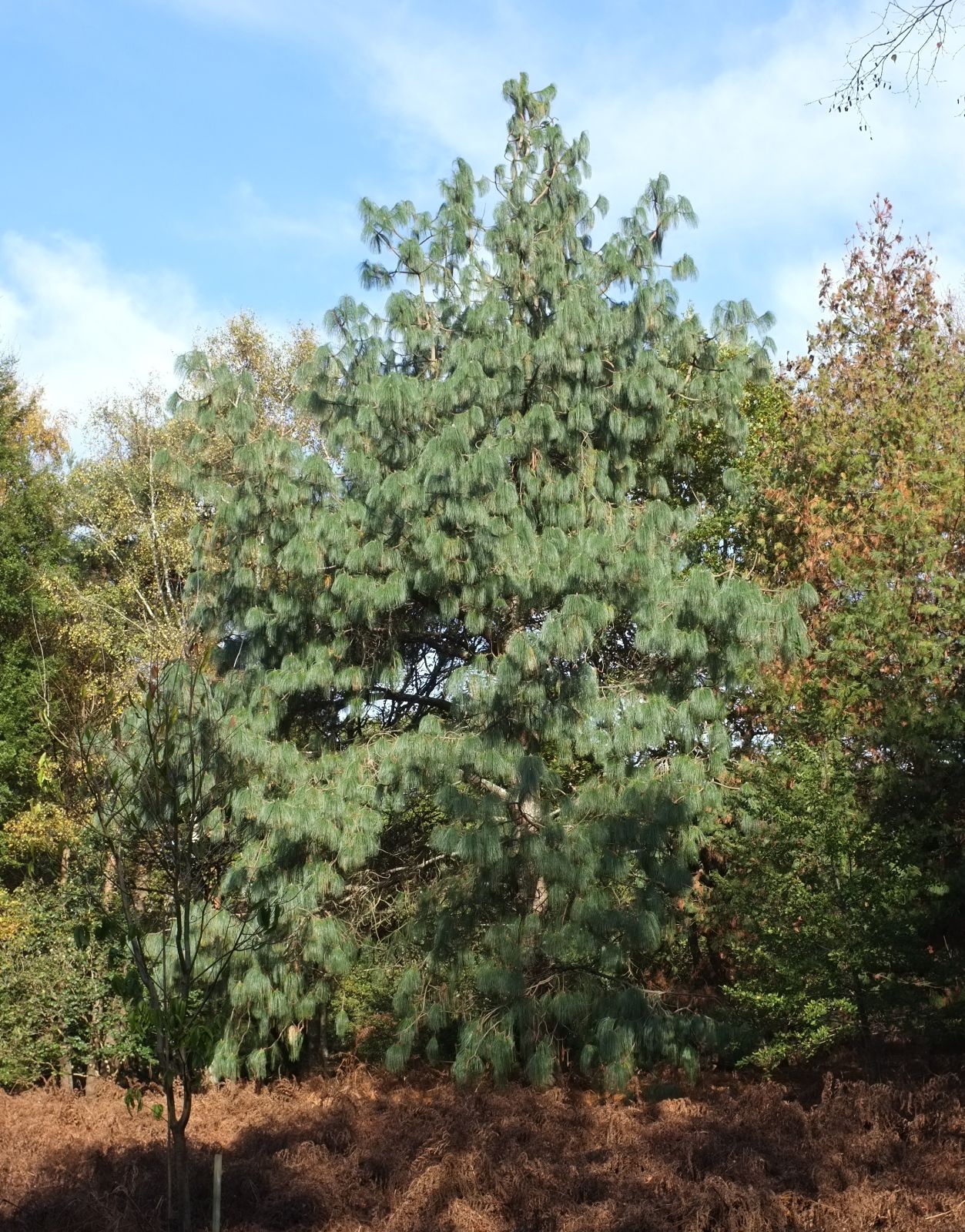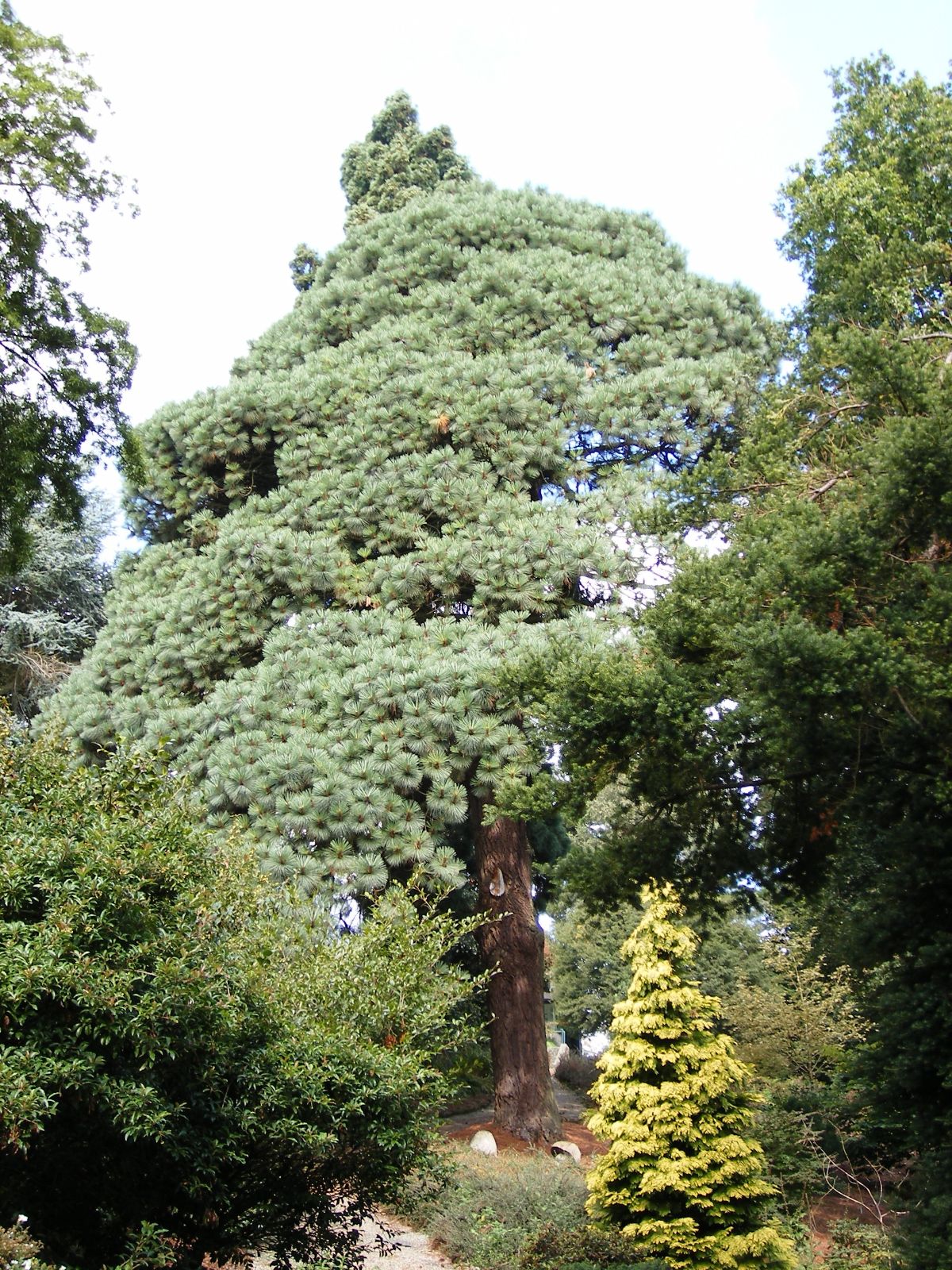Pinus montezumae
Credits
Article from Bean's Trees and Shrubs Hardy in the British Isles
Recommended citation
'Pinus montezumae' from the website Trees and Shrubs Online (treesandshrubsonline.
Genus
Synonyms
- P. devoniana Lindl.
- P. russelliana Lindl.
- P. macrophylla Lindl.
- P. filifolia Lindl.
- Pinus grenvilleae Gord.
- P. gordoniana Hartweg
Infraspecifics
Other taxa in genus
- Pinus albicaulis
- Pinus arizonica
- Pinus armandii
- Pinus attenuata
- Pinus ayacahuite
- Pinus balfouriana
- Pinus banksiana
- Pinus bhutanica
- Pinus brutia
- Pinus bungeana
- Pinus canariensis
- Pinus cembra
- Pinus cembroides
- Pinus chiapensis
- Pinus contorta
- Pinus coulteri
- Pinus culminicola
- Pinus densata
- Pinus densiflora
- Pinus devoniana
- Pinus durangensis
- Pinus echinata
- Pinus edulis
- Pinus elliottii
- Pinus engelmannii
- Pinus eremitana
- Pinus flexilis
- Pinus gerardiana
- Pinus greggii
- Pinus × hakkodensis
- Pinus halepensis
- Pinus hartwegii
- Pinus heldreichii
- Pinus henryi
- Pinus × holfordiana
- Pinus hwangshanensis
- Pinus jeffreyi
- Pinus johannis
- Pinus koraiensis
- Pinus lambertiana
- Pinus leiophylla
- Pinus longaeva
- Pinus massoniana
- Pinus maximartinezii
- Pinus monophylla
- Pinus monticola
- Pinus morrisonicola
- Pinus mugo
- Pinus muricata
- Pinus nelsonii
- Pinus nigra
- Pinus oocarpa
- Pinus orizabensis
- Pinus palustris
- Pinus parviflora
- Pinus patula
- Pinus peuce
- Pinus pinaster
- Pinus pinceana
- Pinus pinea
- Pinus ponderosa
- Pinus pseudostrobus
- Pinus pumila
- Pinus pungens
- Pinus quadrifolia
- Pinus radiata
- Pinus remota
- Pinus resinosa
- Pinus rigida
- Pinus roxburghii
- Pinus sabiniana
- Pinus serotina
- Pinus sibirica
- Pinus strobiformis
- Pinus strobus
- Pinus sylvestris
- Pinus tabuliformis
- Pinus taeda
- Pinus taiwanensis
- Pinus teocote
- Pinus thunbergii
- Pinus torreyana
- Pinus virginiana
- Pinus wallichiana
- Pinus wangii
- Pinus yunnanensis
A tree up to 100 ft high in the wild, with a thick bark, furrowed even on quite young trees; stems rough from the persistent bracts; buds ovoid, with narrow, fringed scales. Leaves usually in fives (occasionally in sixes or sevens), 51⁄2 to 10 in. long, occasionally longer, variable in thickness, flexible, spreading or pendulous, finely toothed, triangular in cross-section, with stomata on all three surfaces; sheaths 3⁄8 to 3⁄4 in. long, sometimes longer. Young cones purple or dark blue, prickly. Mature cones ovoid to narrowly so or cylindrical, 31⁄2 to 6 in. long, sometimes longer, dull or slightly lustrous brown, thick and tough, the exposed part more or less raised, transversely keeled, with a short, usually deciduous prickle.
Native of southern and central Mexico at subtropical and cool temperate latitudes, with its best development at 7,000 to 8,000 ft; also of Guatemala; introduced by Hartweg in 1839. All the trees grown as P. montezumae in Britain are of later date, and their identity is uncertain. They have grey-green leaves which stand out stiffly all round the shoots as in a chimney-sweeper’s brush, whereas in typical P. montezumae the leaves do not have a grey tinge and they are usually more or less drooping; on the other hand they are quite as long as in P. montezumae. The cones should decide the matter, but they do not reach maturity in these cultivated trees. The fact that the leaves are borne in fives is of no significance, since the number of leaves per bundle is not a wholly reliable character for separating P. montezumae from P. hartwegii and P. rudis.
The tree at Grayswood Hill, Haslemere, Surrey, is the oldest of which the planting date is known; accepted as typical P. montezumae by Elwes and Henry, it was planted in 1881 and measures 55 × 91⁄4 ft (1968). A tree at Endsleigh, Devon, must be older than the Grayswood Hill tree; it measured 50 × 91⁄2 ft in 1906 and is now 65 × 14 ft (1970). Others are: Sheffield Park, Sussex, 50 × 7 ft (1968); Bicton, Devon, 69 × 6 ft (1968); Sidbury Manor, Devon, pl. 1902, 48 × 101⁄4 ft (1959); Mount Usher, Co. Wicklow, Eire, pl. 1909, 54 × 93⁄4 ft (1966) and a smaller tree pl. 1925 [Plate 35]. In the National Botanic Garden, Glasnevin, there is an example of 36 × 63⁄4 ft (1974).
Apart from their remarkable foliage, these trees are also very distinct in their broad, dome-shaped crowns.
From the Supplement (Vol. V)
specimens: Grayswood Hill, Haslemere, Surrey, pl. 1881, 60 × 101⁄2 ft (1982); Sheffield Park, Sussex, grafted on P. strobus, 70 × 81⁄4 ft (1984); Red Rice College, Hants, 62 × 63⁄4 ft (1982); Sidbury Manor, Devon, pl. 1902, 56 × 12 ft (1977); Endsleigh, Devon, 51 × 91⁄4 ft (1977); Tregrehan, Cornwall, 85 × 73⁄4 ft (1979); Bodnant, Gwyn., 72 × 91⁄4 ft (1984); Beaufront Castle, Northumb., 38 × 8 ft (1982); Culzean Castle, Ayrs., pl. 1910, 58 × 71⁄4 ft (1984); Cairnsmore, Kirkc., 55 × 81⁄2 ft (1984); National Botanic Garden, Glasnevin, Eire, pl. 1899, 40 × 7 ft (1980); Mount Usher, Co. Wicklow, Eire, pl. 1909, 60 × 11⁄2 ft and, pl. 1925, 51 × 61⁄2 ft (1975); Powerscourt, Co. Wicklow, Eire, pl. 1899, 40 × 7 ft (1980).
P. hartwegii – specimens: Leonardslee, Sussex, 79 × 51⁄4 ft (1979); Cool-hurst, Sussex, 70 × 71⁄4 ft (1976); Bolderwood, New Forest, Hants, 92 × 63⁄4 ft (1979); Eastnor Castle, Heref., 88 × 7 ft (1984).
The specimen of P. pseudostrobus at Blackmoor, Hampshire, mentioned on page 229, measures 70 × 53⁄4 ft (1982).
P hartwegii Lindl.
Synonyms
P. montezumae var. hartwegii (Lindl.) Engelm
Pinus rudis Endl.
Synonyms
Pinus montezumae var. rudis (Endl.) Shaw
Leaves commonly in fives, as in P. montezumae, usually 4 to 6 in. long but occasionally up to 8 in., rigid and usually radiating all round the shoot, light green, glaucous or sometimes yellowish green. Cones resembling those of P. hartwegii but dull brown. According to Martinez it often occurs with P. montezumae, But it ascends in places quite as high up the mountains as P. hartwegii. It is conceivable that the trees grown in Britain as P. montezumae are intermediates between that species and P. rudis. Elwes and Henry, who followed Shaw in treating P. rudis as a variety of P. montezumae, considered that a tree growing in their time at Fota in Co. Cork, Eire, belonged here. Judging from its portrait, it closely resembled in habit what is now grown as typical P. montezumae (Tr. Gr. Brit. & Ire., Plate 278).Another ally of P. montezumae, and more distinct from it than are P. hartwegii and P. rudis, is P. pseudostrobus Lindl., which was introduced by Hartweg in 1839 and described from the specimens he collected in Mexico. It is easily distinguished from those species by its very glaucous, more slender shoots. The bark of young trees is much smoother than in P. montezumae, but becomes rough eventually. The leaves are slender and drooping, as in P. montezumae var. lindleyi. A tree at Pencarrow in Cornwall, planted in 1849, attained a height of 65 ft but died recently. At Blackmoor, Hants, one planted in 1913 is 60 × 5{1/4} ft (1974).
var. lindleyi Loud.
Synonyms
P. lindleyana Gord








